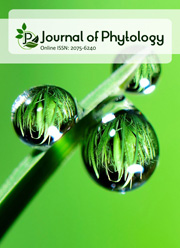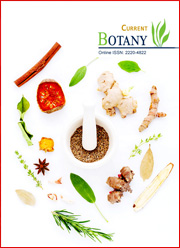Microsatellite marker assisted molecular and morpho-physiological genetic diversity assessment in 38 genotypes of sesame (Sesamum indicum L.)
DOI:
https://doi.org/10.25081/jp.2023.v15.7902Keywords:
Sesame, Gene diversity, Morphological traits, Indigenous crops, SSR markersAbstract
Identification of genetic diversity and their relationships among breeding materials is crucial in crop improvement strategies. In this study, 38 sesame genotypes were characterized for their genetic diversity. The results revealed significant variations among various traits such as plant height, maturity, capsule plant-1 and seeds capsule-1. The number of capsule plant-1 showed significant positive correlation with seeds capsule-1. The highest heritability was found for the numbers of capsules plant-1 (98.67%). The 38 genotypes were separated into six distinct clusters. Comparison within the populations of the cluster IV and those of cluster VI had the highest capsules plant-1, seeds capsule-1 with enormous genetic diversity. For molecular characterization, 7 microsatellite markers and 5 SSR primers with polymorphism were finally chosen for genetic diversity analysis. Altogether, 19 alleles were identified among the 38 genotypes, and the average number of alleles per locus was 3.80. The lowest and the highest numbers of alleles were 3 and 5, respectively. The polymorphism information content (PIC) ranged from 0.3201 to 0.5934 and SI-ssr30 showed to be highest at 0.5934. The UPGMA based clustering depicted a significant variation at molecular level among the sesame genotypes, having a coefficient of similarity between 0.29 and 1.00. The present study confirmed that extensive genetic diversity existed among the sesame genotypes and valuable agronomic traits may result in the development of high yielding genotypes.
Downloads
References
Admas, S., Tesfaye, K., Haileselassie, T., Shiferaw, E., & Flynn, K. C. (2021). Genetic variability and population structure of Ethiopian chickpea (Cicer arietinum L.) germplasm. PLoS One, 16(11), e0260651. https://doi.org/10.1371/journal.pone.0260651
Aglave, H. R. (2018). Physiochemical characteristics of sesame seeds. Journal of Medicinal Plants Studies, 6(1), 64-66.
Ahmed, F., Rabbani, M. G., Islam, M. R., Rahman, M., Malek, M. A., Islam, M. M., & Emon, R. M. (2019). Molecular characterization of some brinjal genotypes (Solanum melongena L) using simple sequence repeat (SSR) markers. African Journal of Agricultural Research, 14(35), 1980-1989. https://doi.org/10.5897/AJAR2019.14449
Ali, A. Y. A., Guisheng, Z., Hassan, A., Yagoub, S. O., Farah, G. A., Ahamed, N. E., Ibrahim, A. M., Ibrahim, M. E. H., Suliman, M., Elradi, S. B., Ibrahim, E. G., & Omer, S. M. (2020). Sesame seed yield and growth traits response to different row spacings in semi-arid regions. Universal Journal of Agricultural Research, 8(4), 88-96. https://doi.org/10.13189/ujar.2020.080402
Araújo, E. S., Arriel, N. H. C., Santos, R. C., & Lima, L. M. (2019). Assessment of genetic variability in sesame accessions using SSR markers and morphoagronomic traits. Australian Journal of Crop Science, 13(1), 45-54. https://doi.org/10.21475/ajcs.19.13.01.p1157
Begna, T. (2021). Role and economic importance of crop genetic diversity in food security. International Journal of Agricultural Science and Food Technology, 7(1), 164-169. https://doi.org/10.17352/2455-815X.000104
Bhattacharjee, M., Iqbal, A., Singha, S., Nath, D., Prakash, S. H., & Dasgupta, T. (2019). Genetic diversity in Sesamum indicum L. Bangladesh Journal of Botany, 48(3), 497-506.
Dossa, K., Diouf, D., Wang, L., Wei, X., Zhang, Y., Niang, M., Fonceka, D., Yu, J., Mmadi, M. A., Yehouessi, L. W., Liao, B., Zhang, X., & Cisse, N. (2017). The Emerging Oilseed Crop Sesamum indicum Enters the “Omics” Era. Frontiers in Plant Science, 8, 1154. https://doi.org/10.3389/fpls.2017.01154
Elleuch, M., Besbes, S., Roiseux, O., Blecker, C., & Attia, H. (2007). Quality characteristics of sesame seeds and by-products. Food Chemistry, 103(2), 641-650. https://doi.org/10.1016/j.foodchem.2006.09.008
Frison, E. A., Cherfas, J., & Hodgkin, T. (2011). Agricultural Biodiversity Is Essential for a Sustainable Improvement in Food and Nutrition Security. Sustainability, 3(1), 238-253. https://doi.org/10.3390/su3010238
Gomez, K. A., & Gomez, A. A. (1984). Statistical Thompson procedures for agricultural research. (2nd ed.). New York, USA: John Willey and Sons.
Kadri, K. (2019). Polymerase Chain Reaction (PCR): Principle and Applications. In M. L. Nagpal, O.-M. Boldura, C. Baltă & S. Enany (Eds.), Synthetic Biology - New Interdisciplinary Science, London, UK: IntechOpen Limited. https://doi.org/10.5772/intechopen.86491
Khatun, M., Rabbant, M. G., & Rahman, E. H. M. S. (2010). Estimate of genetic diversity in snake gourd (Trichosanthes cucumerina). Bangladesh Journal of Agricultural Research, 35(1), 95-100. https://doi.org/10.3329/bjar.v35i1.5870
Li, X., Qiao, L., Chen, B., Zheng, Y., Zhi, C., Zhang, S., Pan, Y., & Cheng, Z. (2021). SSR markers development and their application in genetic diversity evaluation of garlic (Allium sativum L.) germplasm. Plant Diversity, 44(5), 481-491. https://doi.org/10.1016/j.pld.2021.08.001
Liu, K., & Muse, S. V. (2005). PowerMarker: an integrated analysis environment for genetic marker analysis. Bioinformatics, 21(9), 2128-2129. https://doi.org/10.1093/bioinformatics/bti282
McNeill, J., Barrie, F. R., Burdet, H. M., Demoulin, V., Hawksworth, D. L., Marhold, K., Nicolson, D. H., Prado, J., Silva, P. C., Skog, J. E., Wiersema, J. H., & Turland, N. J. (2006). International code of botanical nomenclature (Vienna Code). Regnum Vegetabile, (Vol. 146), Ruggell, Liechtenstein: A.R.G. Gantner Verlag KG.
Minioti, K. S., & Georgiou, C. A. (2010). Comparison of different tests used in mapping the Greek virgin olive oil production for the determination of its total antioxidant capacity. Grasas y Aceites 61(1), 45-51. https://doi.org/10.3989/gya.010508
Nei, M. (1973). Analysis of gene diversity in subdivided populations. Proceeding of National Academy of Sciences, 70(12), 3321-3323. https://doi.org/10.1073/pnas.70.12.3321
Nei, M., Tajima, F., & Tateno, Y. (1983). Accuracy of estimated phylogenetic trees from molecular data. II. Gene frequency data. Journal of Molecular Evolution, 19, 153-170. https://doi.org/10.1007/BF02300753
Pandey, S. K., Das, A., Rai, P., & Dasgupta, T. (2015). Morphological and genetic diversity assessment of sesame (Sesamum indicum L.) accessions differing in origin. Physiology and Molecular Biology of Plants, 21, 519-529. https://doi.org/10.1007/s12298-015-0322-2
Pavan, S., Delvento, C., Ricciardi, L., Lotti, C., Ciani, E., & D’Agostino, N. (2020). Recommendations for Choosing the Genotyping Method and Best Practices for Quality Control in Crop Genome-Wide Association Studies. Frontiers in Genetics, 11, 00447. https://doi.org/10.3389/fgene.2020.00447
Pham, T. D., Geleta, M., Bui, T. M., Bui, T. C., Merker, A., & Carlsson, A. S. (2011). Comparative analysis of genetic diversity of sesame (Sesamum indicum L.) from Vietnam and Cambodia using agro-morphological and molecular markers. Hereditas, 148(1), 28-35. https://doi.org/10.1111/j.1601-5223.2010.02196.x
Rabbani, M. G., Nahe, M. J., & Hoque, S. (2012). Variability, character association and diversity analysis of ridge gourd (Luffa acutangula Roxb.) genotypes of Bangladesh. SAARC Journal of Agriculture, 10(2), 1-10. https://doi.org/10.3329/sja.v10i2.18319
Rosmaina, Syafrudin, Hasrol, Yanti, F., Juliyanti, & Zulfahmi. (2016). Estimation of variability, heritability and genetic advance among local chili pepper genotypes cultivated in peat lands. Bulgarian Journal of Agricultural Sciences, 22(3), 431-436.
Roy, S. C., & Shil, P. (2020). Assessment of Genetic Heritability in Rice Breeding Lines Based on Morphological Traits and Caryopsis Ultrastructure. Scientific Report, 10, 7830. https://doi.org/10.1038/s41598-020-63976-8
Saitou, N., & Nei, M. (1987). The neighbor-joining method-a new method for reconstructing phylogenetic trees. Molecular Biology and Evolution, 4(4), 406-425. https://doi.org/10.1093/oxfordjournals.molbev.a040454
Sen, N., Biswas, K., & Sinha, S. N. (2021). Assessment of genetic divergence through cluster analysis of chilli varieties. Journal of Biosciences, 46, 52. https://doi.org/10.1007/s12038-021-00167-1
Senila, L., Neag, E., Cadar, O., Kovacs, M. H., Becze, A., & Senila, M. (2020). Chemical, nutritional and antioxidant characteristics of different food seeds. Applied Sciences, 10(5), 1589. https://doi.org/10.3390/app10051589
Stavridou, E., Lagiotis, G., Kalaitzidou, P., Grigoriadis, I., Bosmali, I., Tsaliki, E., Tsiotsiou, S., Kalivas, A., Ganopoulos, I., & Madesis, P. (2021). Characterization of the Genetic Diversity Present in a Diverse Sesame Landrace Collection Based on Phenotypic Traits and EST-SSR Markers Coupled With an HRM Analysis. Plants, 10(4), 656. https://doi.org/10.3390/plants10040656
Teklu, D. H., Shimelis, H., & Abady, S. (2022). Genetic improvement in Sesame (Sesamum indicum L.): Progress and Outlook: A Review. Agronomy, 12(9), 2144. https://doi.org/10.3390/agronomy12092144
Teklu, D. H., Shimelis, H., Tesfaye, A., Mashilo, J., Zhang, X., Zhang, Y., Dossa, K., & Shayanowako, A. I. T. (2021). Genetic Variability and Population Structure of Ethiopian Sesame (Sesamum indicum L.) Germplasm Assessed through Phenotypic Traits and Simple Sequence Repeats Markers. Plants, 10(6), 1129. https://doi.org/10.3390/plants10061129
Uzun, B., Lee, D., Donini, P., & ÇAǧirgan, M. L. (2003). Identification of a molecular marker linked to the closed capsule mutant trait in sesame using AFLP. Plant Breeding, 122(1), 95-97. https://doi.org/10.1046/j.1439-0523.2003.00787.x
Wei, P., Zhao, F., Wang, Z., Wang, Q., Chai, X., Hou, G., & Meng, Q. (2022). Sesame (Sesamum indicum L.): A Comprehensive Review of Nutritional Value, Phytochemical Composition, Health Benefits, Development of Food, and Industrial Applications. Nutrients, 14(19), 4079. https://doi.org/10.3390/nu14194079
Wei, X., Liu, K., Zhang, Y., Feng, Q., Wang, L., Zhao, Y., Li, D., Zhao, Q., Zhu, X., Zhu, X., Li, W., Fan, D., Gao, Y., Lu, Y., Zhang, X., Tang, X., Zhou, C., Zhu, C., Liu, L.,…Zhang, X. (2015). Genetic discovery for oil production and quality in sesame. Nature Communications, 6, 8609. https://doi.org/10.1038/ncomms9609
Wu, K., Yang, M., Liu, H., Tao, Y., Mei, J., & Zhao, Y. (2014). Genetic analysis and molecular characterization of Chinese sesame (Sesamum indicum L.) cultivars using insertion-deletion (InDel) and simple sequence repeat (SSR) markers. BMC Genetics, 15, 35. https://doi.org/10.1186/1471-2156-15-35
Yadav, B. P. S., Thiruvengadam, V., Sasikala, R., & Rajendran, L. (2022b). Analysis of genetic diversity in sesame (Sesamum indicum L.) germplasm for yield and its attributing traits. Electronic Journal of Plant Breeding, 13(3), 927-931. https://doi.org/10.37992/2022.1303.121
Yadav, R., Kalia, S., Rangan, P., Pradheep, K., Rao, G. P., Kaur, V., Pandey, R., Rai, V., Vasimalla, C. C., Langyan, S., Sharma, S., Thangavel, B., Rana, V. S., Vishwakarma, H., Shah, A., Saxena, A., Kumar, A., Singh, K., & Siddique, K. H. M. (2022a). Current research trends and prospects for yield and quality improvement in Sesame, an important oilseed crop. Frontiers in Plant Science, 13, 863521. https://doi.org/10.3389/fpls.2022.863521
Yeh, F. C., & Boyle, T. J. B. (1997). Population genetic analysis of co-dominant and dominant markers and quantitative traits. Belgium Journal of Botany, 130, 129-157.
Zidani, S., Ferchichi, A., & Chaieb, M. (2005). Genomic DNA extraction method from pearl millet (Pennisetum glaucum) leaves. African Journal of Biotechnology, 4(8), 862-866.
Published
How to Cite
Issue
Section
Copyright (c) 2023 Reza M. Emon, Md. N. Sakib, Mst. K. Khatun, Md. A. Malek, Md. S. Haque, Md. Amirul Alam

This work is licensed under a Creative Commons Attribution 4.0 International License.





 .
.